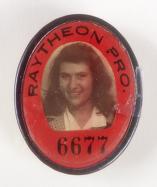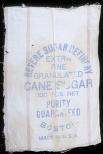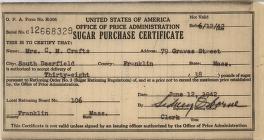|

Identification Badge of a Raytheon Manufacturing Company worker during WWII

Curling Iron

Sugar Sack

WWII Sugar Purchase Certificate
|
Summary and Objective
Students will understand that the nation's need for women to enter the workforce during World War II changed their role in society during that time, and that it was the powerful production of this workforce that ensured victory for the Allied Forces. Students will analyze popular portrayals of women created during World War II.
Teaching Plan
Step 1.
Distribute copies of the image "Rosie to the Rescue" (available at the link below). Talk about women's experiences during World War II. Focus on the experiences of women going to work to increase war production and their work at home toward the war effort and what social conflicts this may have caused for them. The teacher should give a brief description of the roles that a woman living during World War II would have taken on, as represented by Norman Rockwell's picture. As they look at "Rosie to the Rescue," students will identify objects carried by Rosie that represent those different roles.
Step 2.
Distribute copies of the woman's identification badge, the sugar sack, the curling iron and the sugar purchase certificate. Ask students to read the labels beneath each object and discuss how these objects relate to the daily experiences of women during World War II.
Step 3.
Distribute copies of the images "We Can Do It!" and "Rosie the Riveter"(available at the links below) to students. Ask students to compare and contrast these portrayals of Rosie the Riveter. Explain to students what a riveter is (a person who bonds two pieces of metal together with a nail-like bolt. Ships and planes and other war vehicles were made with rivets).
Questions for discussion:
1. What do these two women have in common?
2. What do they look like?
3. How they show their personality through their pose?
4. How do they differ?
5. Which image do you think became more popular with the public during the war?
6. Which image do you like better?
7. What do you think the artist's intent was? Students write their answers to these questions.
Step 4.
As a group the students shares their answers to the questions in Step 3 while examining the pictures.
|




